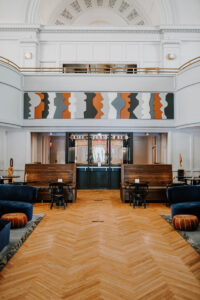
By Ewald Damen, Creative Director/Managing Partner of Virgile + Partners
Digital integration and technology have crept into my life ever since I was born.
The first computer entered our house in the 80’s, the internet in the 90’s and the smartphone in the early 2000’s taking our dependence on tech rapidly to a new level.
Now artificial intelligence has not only seeped into our daily lives through social media and clever algorithms predicting what we want to see and buy, but assists other parts of our lives including the way we work.
Although acutely aware of technology around me and our work in the studio, I am still in slight ignorance of how much AI and algorithms have metamorphosised our work stream and influenced our design process. It has cleverly worked its way in through programs that have become more canny with time. We now use search engines and other tools that allow us to research and develop ideas much faster and more appropriately as they guide us to more relevant search results.
The evolution of digital integration has now seemingly passed the “tech for tech sake” and we have hopefully come to a point where technology is here to service us in a more bespoke way. Gadget digital integration has a limited lifespan and our clients in retail and hospitality are now seeking more intelligent ways to help them with greater innovative solutions that not only service their customers better but provide learnings to better understand their clients or attract a whole new group of clientele. It has opened new ways of communicating with clients at a more personal level through social media, tailored advertising and selling them new bespoke products like NFT’s in the Metaverse.

Social media has not only created more exposure but also raised the bar significantly on creating a high level of innovation and service by presenting a perfect picture of everything we see online. Average is no longer good enough and attention span has decreased, demanding new and better at a rapid pace, requiring brands and spaces to have a considered, and more relevant response. The integration of digital and technology has not only affected what and the way we design things, but it also changed the projects we deliver for a client, as technology itself has become a player in how we go through the design process itself.
As amazed as I am about image generating technologies like Dall-E and Interior planning software like Planner5d, I am still sceptical of AI taking over my life and job, and so I rely on tech with some caution. The software helps us in many ways to present more thought processes but ultimately will not (yet) be the complete answer to our client’s problems or challenges as the outcome of the final solution is still not comparable to a human interaction or edit. The generation of ideas, solutions and visual proposals and suggestions does however have a huge impact on the thought process and speed at which the design can be developed. Intelligent software like image search engines, CAD programs, 3D visualisation tools, AR and VR have helped us enormously throughout the design process and how we communicate our ideas to our clients. They have helped us to create more complex designs with less risk of failure and greater peace of mind for our clients.
I feel we are still in control of AI and algorithms as long as we use them as assisting tools rather than relying on them fully and for every purpose. We can already see problems arising in education where a non-filtered approach to AI when adopted by some students, results in projects and essays that are clearly not produced by the person themselves and arguably limits the personal development of one’s intelligence. My hope is that we can keep developing as human beings to stimulate further innovation and ideas, rather than handing our whole brain and thinking process fully to technology.









